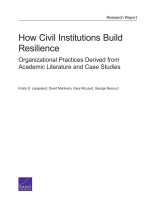| 来源类型 | Research Reports
|
| 规范类型 | 报告
|
| DOI | https://doi.org/10.7249/RR1246
|
| ISBN | 9780833092014
|
| 来源ID | RR-1246-AF
|
| How Civil Institutions Build Resilience: Organizational Practices Derived from Academic Literature and Case Studies |
| Krista Langeland; David Manheim; Gary W. McLeod; George Nacouzi
|
| 发表日期 | 2016
|
| 出版年 | 2016
|
| 页码 | 60
|
| 语种 | 英语
|
| 结论 |
High-Risk Operations Illustrate Best Practices and Lessons Learned Even for Organizations with Low Risk Tolerance- Resilient organizations must prepare for the full spectrum of impact, not just the most likely impact, within practical and financial constraints.
- These organizations establish shared mission awareness by optimizing access to information, emphasizing overall mission objectives, and supporting error reporting and identification of potential problems.
- These organizations build system-specific training programs led by experts.
- These organizations establish a clear hierarchy for decisionmaking, but balance this with appropriate flexibility allotted to personnel.
Adaptability and Flexibility Should Be Measured and Evaluated as an Important Metric for Resilience- Threats can be addressed by building a systematic approach that addresses specific threats in a way that increases general resilience.
- Increased visibility into a system allows enhancements to efficiency and can show how to mitigate vulnerability.
- Flexibility of personnel and operations can be facilitated using standardized processes, disaggregation, and decision postponement.
- Support of a comprehensive understanding of all operations helps to build a dynamic culture that can increase organizational flexibility and responsiveness. Dynamic cultures are sometimes built by fostering continuous communication, distributing decisionmaking power, creating passion for work, and training for disruption.
Following a Disaster, Both Prior Experience and Trained Personnel Can Help to Minimize Recovery Time- Evacuation procedures in response to a threat event, or full-scale exercises conducted prior to threat impact can reveal more efficient methods and time-saving measures that can be incorporated into a periodically edited emergency response plan.
- Incorporating lessons learned from response-planning exercises, false alarms, or earlier emergencies can significantly increase the efficiency and efficacy of future response efforts.
- During disaster response, time is critical, and the speed with which the source of the failure can be identified and addressed is a primary metric for resilience.
- Having experienced personnel on call, supporting shared mission awareness among all personnel, and establishing coordinated reporting procedures can minimize response times during an emergency.
|
| 摘要 |
Common themes emerged throughout the literature and case-study reports that offer guidance for increasing resilience regardless of mission type and threat environment. The following key components of resilient organizations reflect these common themes:
- Information sharing and shared awareness of mission can increase the efficiency and effectiveness of operations both during and following a threat event.
- Clear reporting structures and cultures that support error reporting help allow an organization to develop more resilient operations by incorporating lessons from previous errors.
- Appropriate balance between flexible personnel with distributed decisionmaking and specialized personnel with centralized decisionmaking facilitates better coordination and rapid responses during crises.
- Accurate and comprehensive risk-assessment methods allow both better system design for resilience, and better planning for withstand, adapt, and recover strategies and phases.
- Training for specific threats while maintaining flexibility in response procedures is a challenge, but meeting this challenge will help an organization to address both known and unknown threats.
|
| 主题 | Community Resilience
; Emergency Preparedness
; Public Safety
; United States Air Force
|
| URL | https://www.rand.org/pubs/research_reports/RR1246.html
|
| 来源智库 | RAND Corporation (United States)
|
| 引用统计 |
|
| 资源类型 | 智库出版物
|
| 条目标识符 | http://119.78.100.153/handle/2XGU8XDN/108220
|
推荐引用方式
GB/T 7714 |
Krista Langeland,David Manheim,Gary W. McLeod,et al. How Civil Institutions Build Resilience: Organizational Practices Derived from Academic Literature and Case Studies. 2016.
|
|
文件名:
|
x1495316194594.jpg
|
|
格式:
|
JPEG
|

|
文件名:
|
RAND_RR1246.pdf
|
|
格式:
|
Adobe PDF
|
除非特别说明,本系统中所有内容都受版权保护,并保留所有权利。